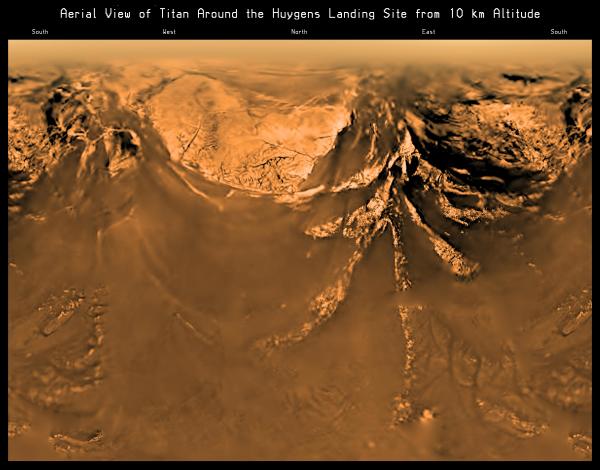Huygens: 'Ground Truth' from An Alien Moon
2005 Historic Descent to Titan Revisited
11 January 2017
After a two-and-a-half-hour descent, the metallic, saucer-shaped spacecraft came to rest with a thud on a dark floodplain covered in cobbles of water ice, in temperatures hundreds of degrees below freezing. The alien probe worked frantically to collect and transmit images and data about its environs – in mere minutes its mothership would drop below the local horizon, cutting off its link to the homeworld and silencing its voice forever.Although it may seem the stuff of science fiction, this scene played out 12 years ago on the surface of Saturn's largest moon, Titan. The "aliens" who built the probe were us. This was the triumphant landing of ESA's Huygens probe.
Huygens, a project of the European Space Agency, travelled to Titan as the companion to NASA's Cassini spacecraft, and then separated from its mothership at 02:00 UTC on 25 December 2004, for a 20-day coast toward its destiny at Titan.
The probe sampled Titan's dense, hazy atmosphere as it slowly rotated beneath its parachutes, analysing the complex organic chemistry and measuring winds. It also took hundreds of images during the descent, revealing bright, rugged highlands that were crosscut by dark drainage channels and steep ravines. The area where the probe touched down was a dark, granular surface, which resembled a dry lakebed.
| Titan touchdown. Click here for video details and downloads. Credit: Huygens descent video: NASA/ESA/University of Arizona/E. Karkoschka; Probe separation animation: NASA/JPL-Caltech; Probe landing animation: ESA |
Thoughts on Huygens
Today the Huygens probe sits silently on the frigid surface of Titan, its mission concluded mere hours after touchdown, while the Cassini spacecraft continues its exploration of Titan from above as part of its mission to learn more about Saturn and its moons. Now in its dramatic final year, the spacecraft's own journey will conclude on 15 September with a fateful plunge into Saturn's atmosphere.
With the mission heading into its home stretch, Cassini team members and NASA leaders look back fondly on the significance of Huygens.
"The Huygens descent and landing represented a major breakthrough in our exploration of Titan as well as the first soft landing on an outer-planet moon. It completely changed our understanding of this haze-covered ocean world."
– Linda Spilker, Cassini project scientist at NASA's Jet Propulsion Laboratory, Pasadena, California
"The Huygens images were everything our images from orbit were not. Instead of the hazy, sinuous features that we could only guess were streams and drainage channels, here was incontrovertible evidence that at some point in Titan's history – and perhaps even now – there were flowing liquid hydrocarbons on the surface. Huygens' images became a Rosetta stone for helping us interpret our subsequent findings on Titan."
– Carolyn Porco, Cassini imaging team lead at Space Science Institute, Boulder, Colorado
"Cassini and Huygens have shown us that Titan is an amazing world with a landscape that mimics Earth in many ways. During its descent, the Huygens probe captured views that demonstrated an entirely new dimension to that comparison and highlights that there is so much more we have yet to discover. For me, Huygens has emphasized why it is so important that we continue to explore Titan."
– Alex Hayes, a Cassini scientist at Cornell University, Ithaca, New York
"Twelve years ago, a small probe touched down on an orangish, alien world in the outer solar system, marking humankind's most distant landing to date. Studying Titan helps us tease out the potential of habitability of this tiny world and better understand the chemistry of the early Earth."
– Jim Green, director of planetary science at NASA Headquarters, Washington
This article was originally published on the NASA JPL website.
Notes for editors
A collection of Huygens' top science findings can be found here.
The Cassini-Huygens mission is a cooperative project of NASA, ESA, and the Italian Space Agency. NASA's Jet Propulsion Laboratory, a division of Caltech in Pasadena, manages the mission for NASA's Science Mission Directorate, Washington. JPL designed, developed and assembled the Cassini orbiter.
More information about Cassini:
http://www.nasa.gov/cassini
http://saturn.jpl.nasa.gov
For further information, please contact:
Preston Dyches
Jet Propulsion Laboratory, Pasadena, California, U.S.A.
Tel: +1-818-394-7013
Email: preston.dyches![]() jpl.nasa.gov
jpl.nasa.gov
Markus Bauer
ESA Science and Robotic Exploration Communication Officer
Tel: +31 71 565 6799
Mob: +31 61 594 3 954
Email: markus.bauer![]() esa.int
esa.int



